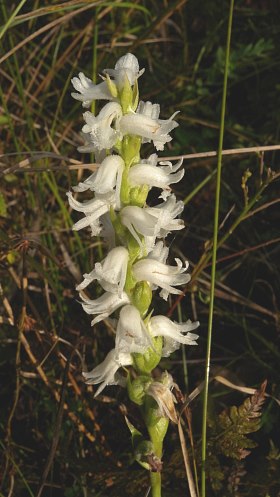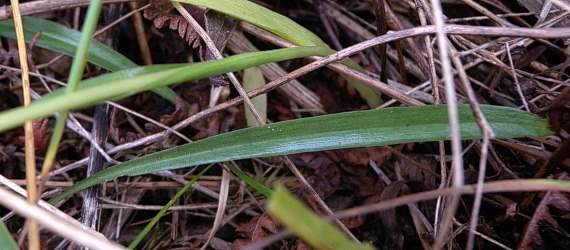Description:
This perennial plant is usually 4-12" tall and unbranched. There is a
rosette of 2-6 strap-like basal leaves that are individually about 3-8"
long and 1/3" (8 mm.) across. They are linear to linear-oblanceolate
with
smooth margins, and usually wither away before the flowers bloom. On
robust specimens, there may be 1 or 2 small leaves on the lower
flowering stalk. The flowering stalk is up to 1' tall, with 6-12
flowers occurring on the upper half. These flowers are arranged on the
stalk as intertwined double spirals – as a result, the individual
spirals are not readily discernible. The flowering stalk is light green
and covered more or less with white glandular hairs. At the base of
each flower, there is a conspicuous green bract that is curved and
narrowly ovate. Each flower is about 1/3" (8 mm.) long, consisting of 3 white
sepals and 3 white petals. The upper sepal and upper two petals are
fused together and form a curved hood that curls upward at its tip,
forming a small upper lip with 3 lobes. The lower petal has a prominent
lip that hangs downward and has a crystalline
appearance, while the lateral sepals are linear and non-spreading.
Together, these sepals and petals form a tubular-shaped flower that
nods downward. The blooming period can occur from late summer until the
fall, and lasts about a month. There is usually a mild floral scent.
Some plants may form cleistogamous flowers. Fertilized flowers are
replaced by pods containing the tiny seeds, which are easily carried
aloft by the wind. These pods may be capable of photosynthesis while
they are green. The root system consists of a cluster of fleshy roots
at the base of the plant that are finger-like in shape, and occasional
rhizomes may be produced. This orchid can reproduce from the seeds of
the flowers, or it may form offsets from rhizomes. Normal growth and
development won't occur unless the root system forms an endomycorrhizal
association with the appropriate species of fungus.
white
sepals and 3 white petals. The upper sepal and upper two petals are
fused together and form a curved hood that curls upward at its tip,
forming a small upper lip with 3 lobes. The lower petal has a prominent
lip that hangs downward and has a crystalline
appearance, while the lateral sepals are linear and non-spreading.
Together, these sepals and petals form a tubular-shaped flower that
nods downward. The blooming period can occur from late summer until the
fall, and lasts about a month. There is usually a mild floral scent.
Some plants may form cleistogamous flowers. Fertilized flowers are
replaced by pods containing the tiny seeds, which are easily carried
aloft by the wind. These pods may be capable of photosynthesis while
they are green. The root system consists of a cluster of fleshy roots
at the base of the plant that are finger-like in shape, and occasional
rhizomes may be produced. This orchid can reproduce from the seeds of
the flowers, or it may form offsets from rhizomes. Normal growth and
development won't occur unless the root system forms an endomycorrhizal
association with the appropriate species of fungus.
Cultivation:
For most ecotypes of this orchid, the preference is full or partial sun
and moist sandy soil. Some ecotypes appear to flourish in thin rocky
soil that is rather dry. Taller, more aggressive plants can out-compete
this orchid for the available light, so it prefers rather open ground
vegetation. Starting plants from seed is quite difficult; on the other
hand, this orchid is easier to transplant than most others. Cultivars
of this orchid species are available from the mass horticultural
market, while local ecotypes are next to impossible to obtain.
Range & Habitat:
Nodding Ladies' Tresses occurs occasionally throughout Illinois, where
it is native; for an
orchid species, it is fairly common (see Distribution
Map).
Habitats
include moist sand prairies, sandy savannas, areas adjacent to paths
in sandy woodlands, shrubby bogs, sandy pannes near lakes,
gravelly seeps, limestone glades, bluffs, sandy pits, ditches, and
abandoned fields. This orchid typically occurs in somewhat disturbed
areas of high quality habitats, and appears to respond positively to
occasional wildfires. Individual plants are usually scattered about,
rather than forming dense colonies.
Faunal Associations:
Both long-tongued and short-tongued bees occasionally visit the flowers
for nectar. The seeds are too small to be of any interest to birds. The
foliage can be eaten by various mammalian herbivores, including
rabbits, groundhogs, and deer, while the fleshy roots are probably
eaten by pocket gophers when individual plants stray into drier areas.
Photographic Location:
The photographed plant was growing in a sandy swale at the Indiana
Dunes National Lakeshore in NW Indiana.

Comments: While rather small-sized, the bright white spike of flowers provides a striking contrast with the background vegetation and is fairly easy to spot. The individual flowers are attractive, particularly when they are viewed close-up; in particular, the lower lip has an intricate crystalline pattern that can vary significantly from flower to flower. Unlike the Ladies' Tresses orchids that form a single spiral of flowers, such as Spiranthes lacera (Slender Ladies' Tresses), the Nodding Ladies' Tresses falls into the group of Spiranthes spp. with double intertwined spirals that are difficult to discern because of the density of flowers on the spike. The Spiranthes spp. in this group are distinguished from each other primarily by considering the variation in the structure of their flowers and the shape of their leaves. Nodding Ladies' Tresses can be distinguished from these other species by the downward curve of its tubular flowers, providing them with a 'nodding' appearance.